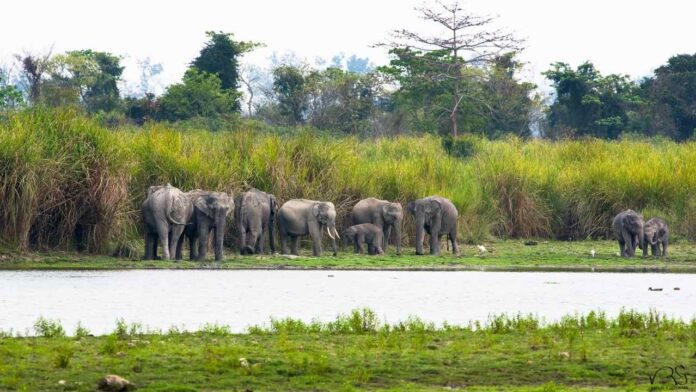Assam, renowned for its rich biodiversity and vast natural landscapes, has achieved a significant milestone in wildlife conservation. According to the latest census conducted in 2024, the state’s elephant population has grown to 5,828, marking a steady increase from previous years. This achievement underscores the effectiveness of ongoing conservation efforts aimed at protecting one of India’s most iconic and endangered species.
The 2024 Elephant Census
The census, conducted by the Assam Forest Department in collaboration with wildlife experts and NGOs, utilized advanced methodologies, including direct observation, dung decay analysis, and the use of drones for monitoring herds in remote areas. Spread across the state’s national parks, wildlife sanctuaries, and reserve forests, the census provided a comprehensive picture of the elephant population.
The results revealed a noticeable rise in the number of elephants, with 5,828 individuals recorded in 2024 compared to 5,719 in the previous census conducted in 2017. This increase highlights the success of conservation initiatives and the growing awareness among communities about the importance of preserving these gentle giants.
Factors Behind the Growth
Several factors have contributed to the growth of Assam’s elephant population, including:
1. Habitat Conservation:
The state government has prioritized the restoration and protection of elephant habitats. Initiatives such as reforestation projects, the creation of elephant corridors, and the preservation of wetlands have provided elephants with safe and sustainable environments to thrive.
2. Anti-Poaching Measures:
Enhanced anti-poaching efforts have played a crucial role in safeguarding elephants from illegal hunting. The deployment of forest guards, advanced surveillance technologies, and strict enforcement of wildlife protection laws have significantly reduced poaching incidents.
3. Community Participation:
Engaging local communities in conservation efforts has been a game-changer. Programs that educate villagers about human-elephant conflict mitigation, along with incentives for participating in conservation, have fostered coexistence and reduced retaliatory actions against elephants.
4. Mitigation of Human-Elephant Conflict:
Assam’s efforts to address human-elephant conflict have included the installation of solar-powered electric fences, trenches, and early warning systems to prevent crop raiding. Compensation schemes for farmers affected by elephant-related damages have also helped reduce tensions between humans and elephants.
Challenges Still Remain
Despite the positive trends, challenges remain in ensuring the long-term survival of Assam’s elephant population. Rapid urbanization, deforestation, and infrastructure development continue to fragment elephant habitats, forcing herds to venture into human settlements in search of food and water.
Human-elephant conflict remains a significant concern, with incidents of crop raiding and accidental deaths of elephants due to train collisions or electrocution reported frequently. Addressing these challenges requires sustained efforts and innovative solutions.
Role of Protected Areas
Assam’s network of protected areas, including Kaziranga National Park, Manas National Park, and Dibru-Saikhowa National Park, has been instrumental in conserving elephants. These parks not only serve as critical habitats but also act as ecological hubs that support a wide range of flora and fauna.
The creation of elephant corridors, such as the Dehing-Patkai corridor, has ensured connectivity between fragmented habitats, enabling elephants to move freely without human interference. These corridors are vital for maintaining genetic diversity and ensuring the health of elephant populations.
Government and NGO Collaboration
The rise in Assam’s elephant population is a testament to the collaborative efforts of the state government, wildlife organizations, and local communities. NGOs like Aaranyak and WWF India have played a significant role in conducting research, raising awareness, and implementing conservation projects.
The Assam government’s policies, such as the Assam Elephant Conservation Plan, have provided a strategic framework for protecting elephants and their habitats. Additionally, international support and funding have further bolstered these efforts.
A Model for Conservation
Assam’s success story serves as a model for other states and countries grappling with wildlife conservation challenges. It demonstrates the importance of integrating scientific research, community engagement, and policy measures to achieve tangible results.
The Road Ahead
While the increase in elephant numbers is a cause for celebration, it is also a reminder of the responsibility to sustain and build on these gains. Ensuring long-term success will require addressing habitat loss, mitigating human-elephant conflict, and fostering greater awareness about the ecological significance of elephants.
As Assam continues its conservation journey, the state’s thriving elephant population stands as a symbol of hope and resilience, inspiring efforts to protect India’s wildlife for generations to come.




